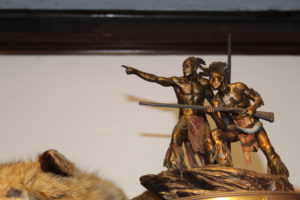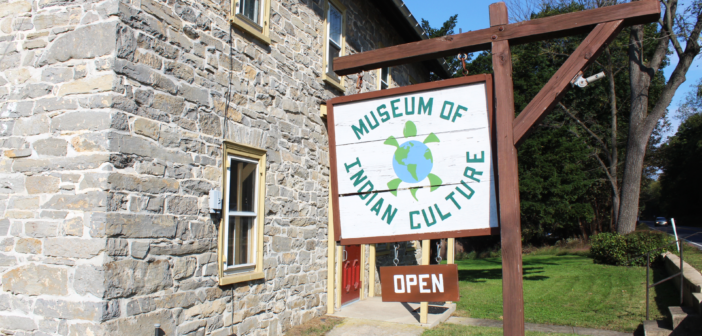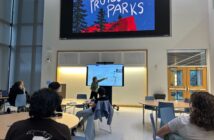Click, whip, whizz.
Click, whip, whizz.
The sounds repeat until the grass field in front of Wesley Dunn, vice president at the Museum of Indian Culture, is dotted with feathered spears. Dunn gingerly lays down his atlatl, a spear-thrower, beside the museum guests and explains its primitive origins as a hunting device, stopping only to crouch and retrieve the arrows he launched feet-deep into the dirt.
“OK, your turn. Just cock your arm and whip it forward,” Dunn said, positioning a woman’s wrist into the appropriate slot. “Let it fly.”
The arrow bends through the air as Dunn grins at the woman, who has now used her first Native American tool. Fifty yards away, a hole in the dirt marks another guest, another lesson and another successful day of work at Allentown’s Museum of Indian Culture.
Located on Fish Hatchery Road, the Museum of Indian Culture strives to present and preserve the culture of Native American tribes across the northeast and broader United States. Since its foundation in 1980, the museum has maintained its nonprofit status while hosting accredited exhibits, programs and festivals.
“Our position here is to educate people about Native American life and culture as it was, basically, from the 1750s and beyond,” said Pat Rivera, the executive director of the museum.

The Museum of Indian Culture features over 4,000 objects and artifacts. The museum contains one of the largest libraries of Native American culture within the area in addition to the interactive exhibits, educational outreach programs and guided tours they offer. (Emily Preble/B&W Staff)(Emily Preble/B&W Staff)
The museum showcases over 4,000 objects, as well as interactive exhibits, expansive libraries, educational outreach programs and guided tours. At the heart of the education process lies Dunn, a specialist in the realm of Native American history and cultural practices.
“He’s probably one of the best historians here in Eastern Pennsylvania as it comes to Native American history,” Rivera said.
But to Dunn, spending hours talking to visitors about jasper stone tools, atlatl training and tepee construction isn’t just his work. It’s his passion.
“I love what I’m doing,” Dunn said. “I’m excited about teaching, and by making other people excited about learning, I’m successful.”
In Dunn’s mind, he said teaching museum guests at least one new thing about early American traditions makes the effort of working at a small, nonprofit museum worthwhile. It’s this same passion for his work that allows the museum to deliver a level of intimacy that most organizations can’t.
Kimberly Roupe, a teacher at West-Mont Christian Academy, has been taking her middle school students to the Museum of Indian Culture for about 30 years. Roupe said the museum’s commitment to authenticity and personal experiences sets the organization apart.
“It’s very hands-on,” Roupe said. “Everything (Dunn) takes out he pretty much lets (my class) touch, which you don’t see much in museums. It’s great for the kids.”
While tours and exhibits make up a large part of the education process, the museum also hosts annual festivals where people from the Lehigh Valley and beyond can come celebrate Native American culture via dances, demonstrations and displays.
Rivera said its annual August festival epitomizes the museum’s principal mission: connecting the community over shared learning. Nearly 5,000 people attend. Be it esteemed tribe leaders flying across the country or Allentown locals driving down the road, attendants of the festival have the opportunity to connect with one another in an environment unmatched by any other organization in the Lehigh Valley.
“It’s amazing how this place absolutely transforms,” Rivera said.
For Ed Gearheart, “transformational” just scrapes the surface. Gearheart attended his first festival as a dancer a few years ago. Now, he drives 60 miles round trip to volunteer at the museum and practice his tepee construction skills.
“Something about this place draws you in, and if it likes you, it’ll keep you,” Gearheart said. “I just get re-energized being here.”
For Rivera and her team, work is never done. Rivera wants to do more to draw members of the community into the museum and share what the museum has to offer. First on the agenda: creating a Lenape Woodland village to teach about the lifestyle of early Northeastern Americans. To Rivera, the Woodland village would be the perfect extension of the museum’s educational repertoire. Even more fitting, the village would sit atop land that Lenape tribes actually used to inhabit.
“This was an old Lenape pathway many years ago, and to be able to bring a woodland village here… gosh,” Rivera said. “I just got chills.”
For now, however, the Museum of Indian Culture intends to do business one atlatl demonstration at a time. Rivera said they strive to foster community by giving every visitor a personalized experience and an intimate view of the passion that keeps the museum running.
“It’s a special place,” Roupe said. “It’s a small-town museum that’s steeped in history and culture of the area, and you just don’t have a lot of places like that.”






Comment policy
Comments posted to The Brown and White website are reviewed by a moderator before being approved. Incendiary speech or harassing language, including comments targeted at individuals, may be deemed unacceptable and not published. Spam and other soliciting will also be declined.
The Brown and White also reserves the right to not publish entirely anonymous comments.